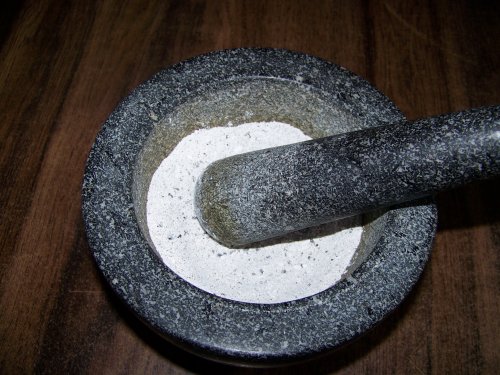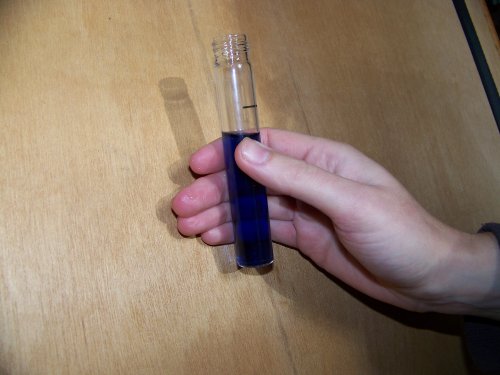Bone Ash Broth - a paleo source of minerals?
For those still living in the Paleo era (literally under rock), it may come as a shock that bone broth is not a great source of minerals.
If this upsets you, then feel free to shoot down the messenger:
www.alive.com/health/bone-broth-analysis-reader-research/
But what about bone-ash broth?
Could this be the missing ingredient that can fortify your broth into a mineral superfood?
Thanks to my handy waterwatch kit, I thought I would do some preliminary research on this.
Method

Take some bones and burn them in the fire. (Yes it will produce a horrible smell). After several days of keeping the house warm, collect the burnt bones from the ash.
Grind the bones into a fine powder and mix the powder with cold water. Filter out the sediment with paper towel and measure the salinity, PH and reactive phosphorous levels.
Results

Reactive Phosphorous shows as purple.
The water (from our rain water tanks) had the following analysis:
Salinity: 60µS (very low)
PH: 6.7 (very so slightly acidic)
Reactive Phosphorous: < 0.015mg/L (very low)
Temperature: 17.7°
20 grams of powdered bone ash was mixed with 100mls of cold rain water (as above). This was stirred for a few minutes. The resulting suspension was then tipped off leaving most of the bone ash as sediment.
Cold Bone Ash water analysis:
Salinity: 300mS (very weak brine)
PH: 10.4 (alkaline)
Reactive Phosphorous: 45mg/L
Taste: like hard water - not offensive!
Discussion
While able to demonstrate some solubility of bone ash minerals, the levels of reactive phosphorous were still modest. At 45mg/L this solution is still very low in Phosphorous compared to milk (~900mg/L). The Alkalinity of the solution seems to indicate that hydroxide ions and bi-phosphate ions have dissolved, so therefore we have dissolved calcium in the solution (to maintain charge balance).
The solubility of these minerals may be improved by buffering the PH - ie using vinegar, and boiling the solution could have an effect also.
I think there is potential that bone-ash could be the missing ingredient in a paleo bone broth. However the solubility of phosphate and calcium is unpredictable in such cooking. Certainly far more remains in the solid form than dissolves.
Given that bone ash is very brittle and can be powdered, it should also be considered that the powder itself can be consumed as a medicine, and stomach acids may extract far more than the broth can dissolve?
Finally, the value of bone ash over wood ash should be considered. The latter is also high in calcium, but much lower in phosphorous. Wood ash is likely to contain some toxic minerals also, like arsenic, mercury and cadmium which the bone ash will be much lower in.
If this upsets you, then feel free to shoot down the messenger:
www.alive.com/health/bone-broth-analysis-reader-research/
But what about bone-ash broth?
Could this be the missing ingredient that can fortify your broth into a mineral superfood?
Thanks to my handy waterwatch kit, I thought I would do some preliminary research on this.
Method

Take some bones and burn them in the fire. (Yes it will produce a horrible smell). After several days of keeping the house warm, collect the burnt bones from the ash.
Grind the bones into a fine powder and mix the powder with cold water. Filter out the sediment with paper towel and measure the salinity, PH and reactive phosphorous levels.
Results

Reactive Phosphorous shows as purple.
The water (from our rain water tanks) had the following analysis:
Salinity: 60µS (very low)
PH: 6.7 (very so slightly acidic)
Reactive Phosphorous: < 0.015mg/L (very low)
Temperature: 17.7°
20 grams of powdered bone ash was mixed with 100mls of cold rain water (as above). This was stirred for a few minutes. The resulting suspension was then tipped off leaving most of the bone ash as sediment.
Cold Bone Ash water analysis:
Salinity: 300mS (very weak brine)
PH: 10.4 (alkaline)
Reactive Phosphorous: 45mg/L
Taste: like hard water - not offensive!
Discussion
While able to demonstrate some solubility of bone ash minerals, the levels of reactive phosphorous were still modest. At 45mg/L this solution is still very low in Phosphorous compared to milk (~900mg/L). The Alkalinity of the solution seems to indicate that hydroxide ions and bi-phosphate ions have dissolved, so therefore we have dissolved calcium in the solution (to maintain charge balance).
The solubility of these minerals may be improved by buffering the PH - ie using vinegar, and boiling the solution could have an effect also.
I think there is potential that bone-ash could be the missing ingredient in a paleo bone broth. However the solubility of phosphate and calcium is unpredictable in such cooking. Certainly far more remains in the solid form than dissolves.
Given that bone ash is very brittle and can be powdered, it should also be considered that the powder itself can be consumed as a medicine, and stomach acids may extract far more than the broth can dissolve?
Finally, the value of bone ash over wood ash should be considered. The latter is also high in calcium, but much lower in phosphorous. Wood ash is likely to contain some toxic minerals also, like arsenic, mercury and cadmium which the bone ash will be much lower in.
